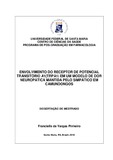| dc.creator | Pinheiro, Francielle de Vargas | |
| dc.date.accessioned | 2013-07-12 | |
| dc.date.available | 2013-07-12 | |
| dc.date.issued | 2012-05-26 | |
| dc.identifier.citation | PINHEIRO, Francielle de Vargas. Involvement of transient receptor potential A1(TRPA1) on model of neuropathic pain sympathetically maintained in mice. 2012. 80 f. Dissertação (Mestrado em Farmácia) - Universidade Federal de Santa Maria, Santa Maria, 2012. | por |
| dc.identifier.uri | http://repositorio.ufsm.br/handle/1/8981 | |
| dc.description.abstract | Some forms of neuropathic pain are maintained by sympathetic fibers, but the underlying mechanisms are poorly understood. Thus, the aim of this study was to investigate the possible involvement of the TRPA1 receptor as well as the role of the sympathetic nervous system (involved in sympathetically maintained neuropathic pain) in a model of neuropathic pain induced by chronic sciatic nerve constriction injury (CCI) in mice. The systemic injection of the selective TRPA1 antagonist HC-030031 reversed both mechanical and cold allodynia induced by chronic sciatic nerve constriction injury. Nerve injury also sensitizes mice to the nociception induced by the intraplantar injection of a low dose of the TRPA1 agonist allyl isothiocyanate without changing TRPA1 immunoreactivity in the injected paw. Furthermore, the chemical sympathectomy produced by guanethidine largely prevented CCI-induced mechanical and cold allodynia. CCI also induced a norepinephrine-trigged nociception that was inhibited by α-adrenoceptor antagonism and norepinephrine transporter and monoamine oxidase inhibition. Finally, the peripheral injection of HC-030031 also largely reduced CCI-induced nociception by norepinephrine and mechanical or cold allodynia. Taken together, the present findings reveal the critical role of TRPA1 in mechanical and cold hypersensitivity as well as in hypersensitivity to norepinephrine following nerve injury. This article presents the role of TRPA1 receptor on the sympathetically-maintained nociception induced by nerve injury in
mice. Our results suggest that TRPA1 antagonists may be useful to treat neuropathic patients that present sympathetically maintained pain. | eng |
| dc.description.sponsorship | Coordenação de Aperfeiçoamento de Pessoal de Nível Superior | |
| dc.format | application/pdf | por |
| dc.language | por | por |
| dc.publisher | Universidade Federal de Santa Maria | por |
| dc.rights | Acesso Aberto | por |
| dc.subject | Contrição crônica do nervo ciático | por |
| dc.subject | Antagonista TRPA1 | por |
| dc.subject | Norepinefrina | por |
| dc.subject | Adrenoreceptor | por |
| dc.subject | Alodínia frio | por |
| dc.subject | Alodínia mecânica | por |
| dc.subject | Chronic constriction injury | eng |
| dc.subject | TRPA1 antagonist | eng |
| dc.subject | Norepinephrine | eng |
| dc.subject | Adrenoceptor | eng |
| dc.subject | Cold allodynia | eng |
| dc.subject | Mechanical allodynia | eng |
| dc.title | Envolvimento do receptor de potencial transitório A1 (TRPA1) em um modelo de dor neuropática mantida pelo simpático em camundongos | por |
| dc.title.alternative | Involvement of transient receptor potential A1(TRPA1) on model of neuropathic pain sympathetically maintained in mice | eng |
| dc.type | Dissertação | por |
| dc.description.resumo | Algumas formas de dor neuropática são mantidos por fibras simpáticas, contudo os mecanismos subjacentes são pouco compreendidos. Assim, o objetivo deste estudo foi investigar o possível envolvimento do receptor TRPA1, bem como o papel do sistema nervoso simpático num modelo de dor neuropática induzido pela constrição crônica do nervo ciático (CCI) em camundongos. A administração sistêmica do antagonista seletivo do receptor TRPA1, HC-030031, reverteu a alodinia mecânica e ao frio induzida pela CCI. A injeção de uma baixa dose do agonista do receptor TRPA1, isotiocianato de alila, induziu uma resposta nociceptiva nos animais que sofreram a lesão no nervo, sem alterar a imunorreatividade do TRPA1 na pata injetada. Além disso, a simpatectomia química produzida pela guanetidina amplamente previniu a alodínia mecânica e ao frio induzida pela CCI. Ainda, a injeção intraplantar de norepinefrina induziu nocicepção espontânea, a qual foi reduzida pelo antagonista α-adrenérgico, inibidor do transportador de norepinefrina e inibidor da enzima monoamina oxidase.
Finalmente, a administração periférica do HC-030031 reduziu a nocicepção espontânea induzida pela norepinefrina e também a alodínia mecânica e térmica de animais neuropáticos. Assim, nossos resultados revelam o papel crítico do receptor TRPA1 na alodínia mecânica e ao frio, bem como na hipersensibilidade à
norepinefrina após lesão do nervo em um modelo de dor neuropática mantida pelo simpático. Dessa forma, o receptor TRPA1 poderá ser um alvo para o desenvolvimento de novos tratamentos para esse tipo de dor. | por |
| dc.contributor.advisor1 | André, Eunice | |
| dc.contributor.advisor1Lattes | http://lattes.cnpq.br/8906770743620827 | por |
| dc.contributor.advisor-co1 | Ferreira, Juliano | |
| dc.contributor.advisor-co1Lattes | http://lattes.cnpq.br/2694197910478313 | por |
| dc.contributor.referee1 | Werner, Maria Fernanda de Paula | |
| dc.contributor.referee1Lattes | http://lattes.cnpq.br/9053828782958389 | por |
| dc.contributor.referee2 | Fachinetto, Roselei | |
| dc.contributor.referee2Lattes | http://lattes.cnpq.br/7203076675431306 | por |
| dc.creator.Lattes | http://lattes.cnpq.br/9667632794463116 | por |
| dc.publisher.country | BR | por |
| dc.publisher.department | Farmacologia | por |
| dc.publisher.initials | UFSM | por |
| dc.publisher.program | Programa de Pós-Graduação em Farmacologia | por |
| dc.subject.cnpq | CNPQ::CIENCIAS BIOLOGICAS::FARMACOLOGIA | por |


